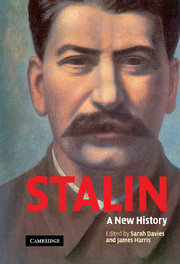Book contents
- Frontmatter
- Contents
- Notes on contributors
- Preface
- A note on transliteration
- Glossary
- 1 Joseph Stalin: power and ideas
- 2 Stalin as Georgian: the formative years
- 3 Stalin as Commissar for Nationality Affairs, 1918–1922
- 4 Stalin as General Secretary: the appointments process and the nature of Stalin's power
- 5 Stalin as Prime Minister: power and the Politburo
- 6 Stalin as dictator: the personalisation of power
- 7 Stalin as economic policy-maker: Soviet agriculture, 1931–1936
- 8 Stalin as foreign policy-maker: avoiding war, 1927–1953
- 9 Stalin as Marxist: the Western roots of Stalin's russification of Marxism
- 10 Stalin as Bolshevik romantic: ideology and mobilisation, 1917–1939
- 11 Stalin as patron of cinema: creating Soviet mass culture, 1932–1936
- 12 Stalin as producer: the Moscow show trials and the construction of mortal threats
- 13 Stalin as symbol: a case study of the personality cult and its construction
- 14 Stalin as the coryphaeus of science: ideology and knowledge in the post-war years
- Index
12 - Stalin as producer: the Moscow show trials and the construction of mortal threats
Published online by Cambridge University Press: 24 November 2009
- Frontmatter
- Contents
- Notes on contributors
- Preface
- A note on transliteration
- Glossary
- 1 Joseph Stalin: power and ideas
- 2 Stalin as Georgian: the formative years
- 3 Stalin as Commissar for Nationality Affairs, 1918–1922
- 4 Stalin as General Secretary: the appointments process and the nature of Stalin's power
- 5 Stalin as Prime Minister: power and the Politburo
- 6 Stalin as dictator: the personalisation of power
- 7 Stalin as economic policy-maker: Soviet agriculture, 1931–1936
- 8 Stalin as foreign policy-maker: avoiding war, 1927–1953
- 9 Stalin as Marxist: the Western roots of Stalin's russification of Marxism
- 10 Stalin as Bolshevik romantic: ideology and mobilisation, 1917–1939
- 11 Stalin as patron of cinema: creating Soviet mass culture, 1932–1936
- 12 Stalin as producer: the Moscow show trials and the construction of mortal threats
- 13 Stalin as symbol: a case study of the personality cult and its construction
- 14 Stalin as the coryphaeus of science: ideology and knowledge in the post-war years
- Index
Summary
Long before the judges entered the courtroom to preside over the August 1936 case of the Trotskyite-Zinovievite Terrorist Centre, show trials had become an established feature of Soviet political life. The trial of the Socialist Revolutionaries, the Shakhty trial, the trial of the Industrial Party, the Menshevik trial, and the Metro-Vickers trial were but the most publicised of this genre of political struggle played out on a judicial stage. But the Moscow show trials of 1936, 1937, and 1938 differed from their predecessors in three significant ways: the political composition of the defendants; the seriousness of the threats that the defendants allegedly posed; and the use of the defendants' confessions, and the trials' verdicts, to justify a conspiratorial explanation of politics and mass repression. For these reasons, these trials stand apart from the other show trials of the Soviet period and they continue to fascinate and perplex. This essay examines these trials to explore how Stalin used them to construct a series of threats, to define who and what constituted the threats, and to mobilise citizens to unmask and crush those threats. In short, it explores what the show trials sought to show.
The Bolsheviks hardly originated the idea of using the judicial system to construct and expose threats to a community. On the contrary, the use of the judicial system for such ends is a longstanding European tradition. Lenin appreciated the power of show trials and was keen to use them against those who threatened the new Soviet state.
- Type
- Chapter
- Information
- StalinA New History, pp. 226 - 248Publisher: Cambridge University PressPrint publication year: 2005
- 2
- Cited by



